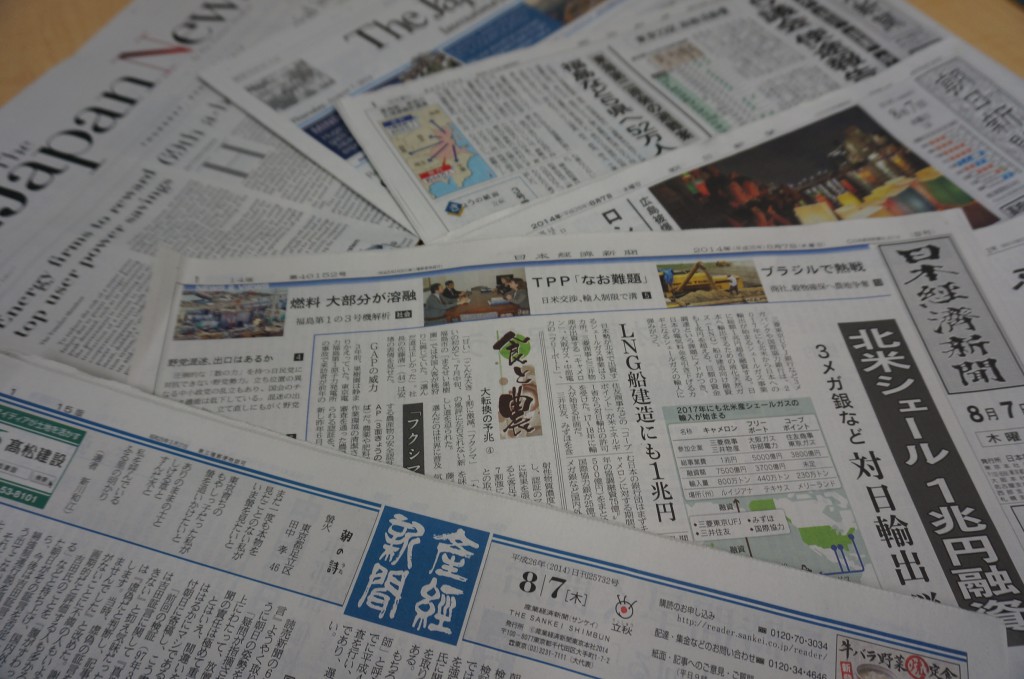A summary of editorials from leading Japanese newspapers (November 7, 2014)
A summary of editorials from leading Japanese newspapers, posted biweekly.
The Bank of Japan announced on Oct. 31 that it would take additional monetary easing measures after its Policy Board narrowly voted for expanding the country’s monetary base at an annual pace of \80 trillion, up from the previously targeted pace of \60 trillion to \70 trillion.
“This shows our unshakable determination to end deflation,” Kuroda said at a press conference on that day, underscoring his resolve to achieve a 2-percent inflation target sometime next year. The surprise announcement has sent stock prices soaring and the yen’s exchange rate plummeting worldwide.
The five national dailies wrote about the monetary easing policy in their editorials on Nov. 1 with The Nihon Keizai Shimbun (Nikkei), The Sankei Shimbun and The Yomiuri Shimbun supporting the move and The Asahi Shimbun and The Mainichi Shimbun expressing strong concerns.
Qualified support
The Nikkei said it would respect the BOJ decision to conduct operations to end the deflation that has been afflicting Japan for more than 15 years. “It is understandable that the Bank of Japan tried to do its utmost to break away from deflation by making a swift move at this juncture,” when the rate of consumer price increase is slowing.
The Yomiuri said the central bank “has demonstrated its firm resolve to end deflation by presenting a drastic monetary-easing policy” and “was right to respond to changes in economic conditions swiftly.”
The Sankei also expressed support: “The central bank’s quantitative and qualitative monetary easing policy is aimed at erasing the widespread deflation mentality found in the Japanese economy by fueling expectations that Japan will stably realize the inflation rate of 2 percent. It is a matter of course that [the central bank] tries to ensure that will happen.”
The three newspapers, however, were not without concerns.
“Of course, there is a side effect from the additional monetary easing steps: a bloated monetary base,” The Nikkei said. “If the additional measures cause the yen to drastically depreciate, consumer prices will tend to increase due to higher import prices. But, it would hardly be a desirable break-away from deflation if the price increase does not accompany higher wages and more jobs.”
The Sankei also expressed concerns about the rapidly depreciating yen. “The weak yen will help exporting firms improve earnings, but excessive depreciation of the currency will deal a blow to small- and medium-sized companies outside the major metropolitan areas, which depend on imported raw materials. We have to bear this in mind.”
The Yomiuri said “optimism is not warranted.” Although the central bank’s policy has nearly doubled the amount of funds in circulation, the outstanding lending of financial institutions has risen by only 2 percent year-on-year, it said.
Both The Nikkei and The Yomiuri expressed concerns that the bank’s operations could be taken as attempts to make up for fiscal deficits. If this belief spreads worldwide, it will impair the credibility of the central bank as well as Japan’s government bonds, they said.
Reconsideration needed
This concern is shared by The Mainichi, which said, “If investors were to believe that the BOJ accepts a huge amount of the government’s debts, international confidence in Japan would be lost, causing the market prices of government bonds to plummet and rates of long-term interest on such bonds to rise, which could throw Japan’s economy into chaos.”
“The BOJ has ventured deeply into a dangerous area that it should not, as the central bank, have entered in the first place,” The Mainichi warned.
The Asahi echoed this sentiment. “If it holds government bonds longer, the BOJ will have to take a larger risk while the assets on its balance sheet keep growing. This will also make it harder for the central bank to work out an effective exit strategy for its monetary stimulus program.”
The Asahi also questioned if the inflation target of 2 percent in two years that the bank set in April last year is viable. “The question that should be asked is whether the BOJ should rather have reviewed its target…What appears certain is that it will now take longer for the BOJ to wind down its radical easing campaign.”
Government’s role
The Nikkei, The Sankei and The Yomiuri, meanwhile, urged the government to steadily implement measures spelled out in its growth strategy if Japan wants to end deflation and attain economic revitalization.
*English translations of The Yomiuri, The Asahi, and The Mainichi are from The Japan News, The Asia & Japan Watch and The Mainichi, respectively. Those for The Sankei and The Nikkei are provisional. The content of this page was made by the Foreign Press Center/Japan and does not reflect the opinion of the Japanese Government or any other organization.



